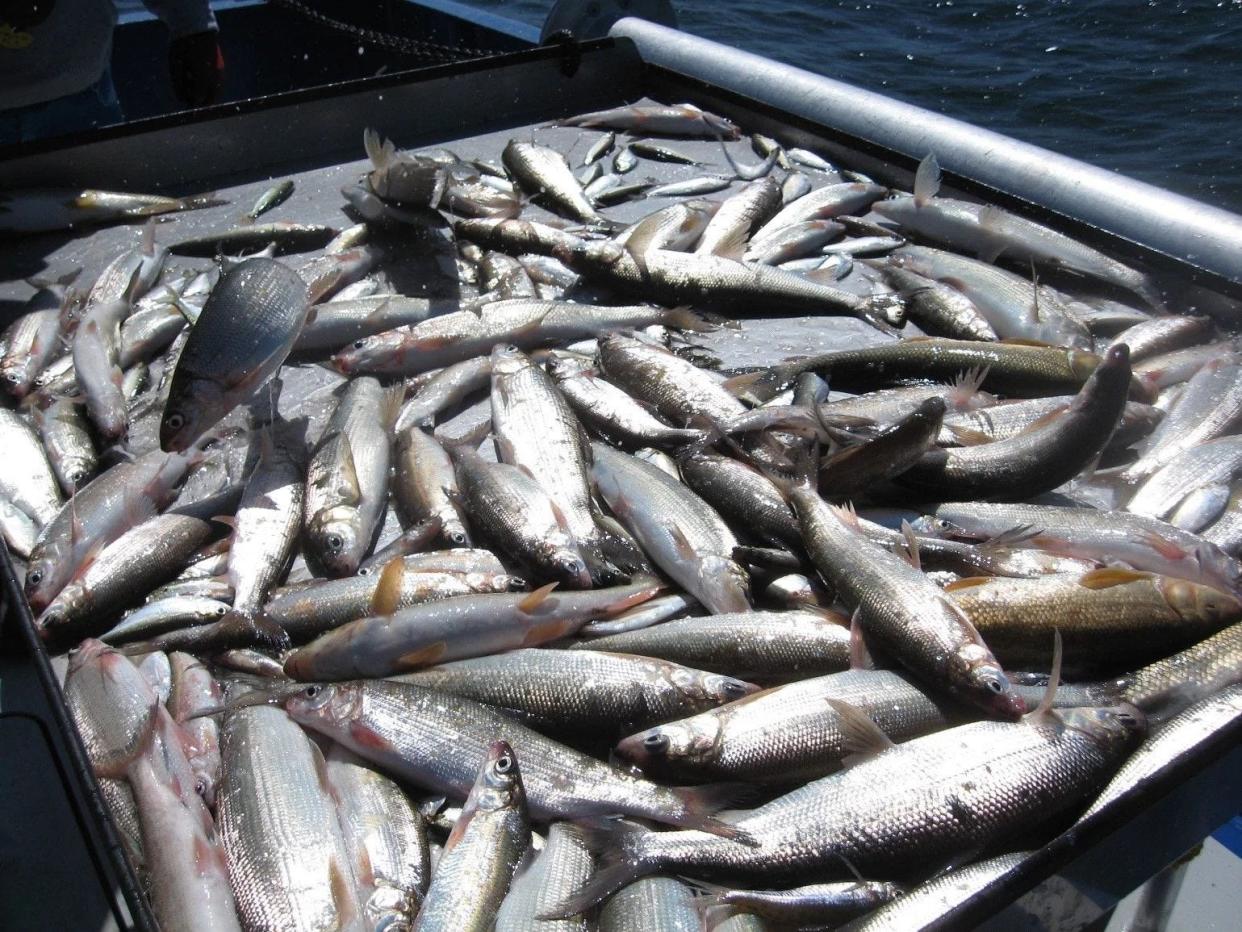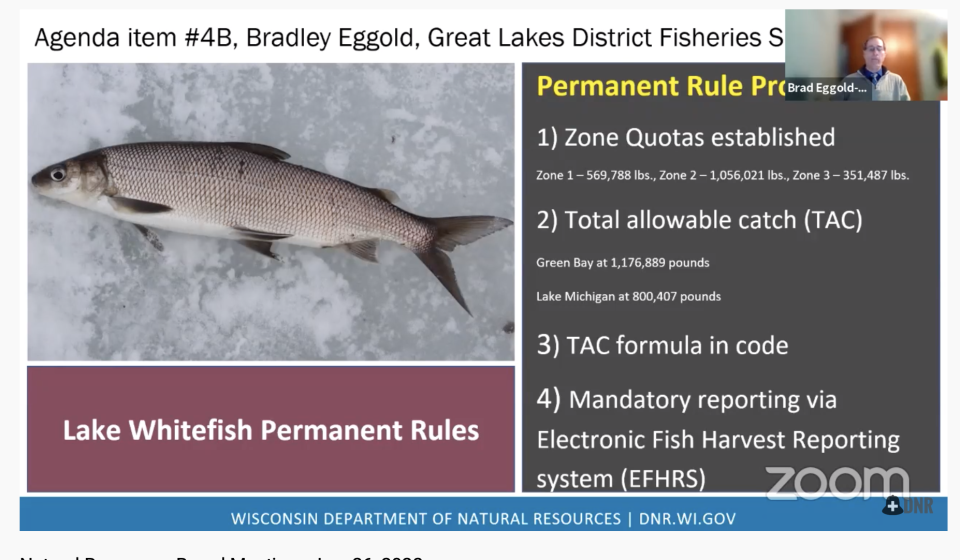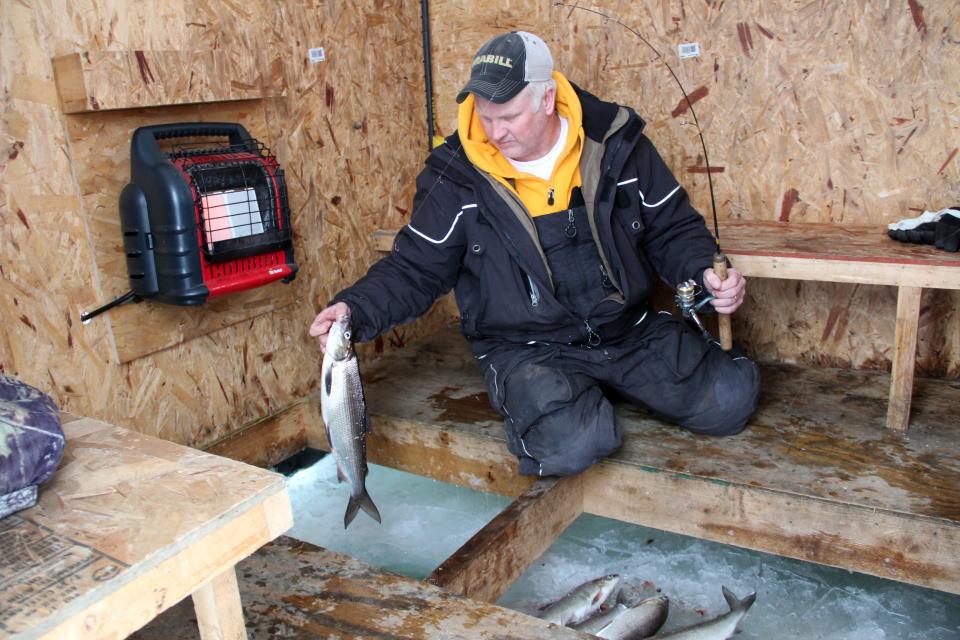Smith: After public complaints, NRB approves smaller quota increase for Green Bay whitefish

- Oops!Something went wrong.Please try again later.
The commercial fishing quota for lake whitefish in southern Green Bay will increase by 57%, according to a final rule approved Wednesday by the Natural Resources Board.
But that's less than half of what had been proposed in early January by the Department of Natural Resources.
The agency dialed down the hike after receiving pushback during a public comment period this month, including from members of the sport fishing community.
The final rule approved Wednesday sets an annual whitefish quota of 569,788 pounds for Zone 1 in southern Green Bay, 1.06 million pounds for Zone 2 (northern Green Bay and Wisconsin's waters of Lake Michigan north of Algoma) and 351,487 pounds for Zone 3 (Lake Michigan south of Algoma).

The earlier proposal would have increased the Zone 1 quota to 800,000 pounds; the previous permanent rule set it at 362,185 pounds.
The new commercial fishing regulations are in response to changing conditions in the Wisconsin waters of Green Bay and Lake Michigan as well as several years of work to obtain commercial fishing bycatch and mortality data.
From 2008-18 the Green Bay whitefish population increased from about 6 million fish to about 16 million, according to the DNR, with a corresponding increase in whitefish spawning biomass from about 15 million pounds to about 37 million.
The resurgence of the native species has created a thriving winter sport fishery for whitefish on the bay.
But at the same time the Moonlight Bay whitefish stock on the eastern side of the Door Peninsula, for decades the strongest whitefish stock in the Wisconsin waters of Lake Michigan, has declined.
According to the DNR, a Jan. 4 public hearing resulted in 132 written comments to a proposal to increase the commercial quota to 800,000 pounds, including 62 in opposition, 60 in support and seven with a mix of support and opposition for various portions of it.

In general, sport anglers were opposed due to concerns about bycatch of walleyes and other popular sport species as well as latent mortality to whitefish. About 50% of whitefish landed by commercial trap netters are released because they are undersized, according to the recent UW-Green Bay study.
And commercial fishermen were opposed to a proposed "restricted zone" in southern Green Bay where netting would be limited.
The DNR responded by allowing a smaller quota increase than originally proposed, removing the restricted zone and instead allowing only one trap net set per license and including a provision to increase the quota in the future.
Brad Eggold, DNR Lake Michigan fisheries manager, said the modified rule approved Wednesday addressed public comments by: providing additional protection for the sport fishery; allowing additional time to gather data, especially on latent mortality of released fish; allowing for commercial quota increases after 2023 if supported by data, stakeholder involvement and modeling results; and striking a good balance between the science and socio-political dynamics of the fishery.
As part of the rule, commercial fishermen will also be required to use an electronic catch reporting system as well as report bycatch.
If it passes legislative review, the rule should go into effect in July, Eggold said. The DNR plans to continue to collect data and run its whitefish population model again in 2023.
Any potential changes in the whitefish quota or rules would then be presented to the public and NRB in the summer or fall of 2023.
NRB officer elections: Per custom, the Natural Resources Board held its annual election of officers Wednesday at the end of its January meeting.
Greg Kazmierski of Pewaukee was elected as chair, Bill Bruins of Waupun as vice-chair and Bill Smith of Shell Lake as secretary.
Kazmierski is an archery shop owner who was appointed to the board in 2011 and 2017 by Gov. Scott Walker. He served as vice-chair last year. His term expires May 1, 2023.
Bruins is a dairy farmer who also was appointed by Gov. Walker in 2011 and 2017.
Smith is a former Air Force officer and retired DNR manager who was appointed to the board in 2019 by Gov. Tony Evers. His term expires in 2025.
Fred Prehn of Wausau, chairman since 2019, was ineligible for reelection due to a board rule that prohibits a member from serving in the role for more than three years in a row.
Prehn, whose term expired May 1, continues to refuse to vacate his seat on the board, citing a 1964 Wisconsin Supreme Court ruling that allows board members to remain in place until their replacement has been confirmed by the Senate.
The Committee on Senate Organization has refused to give a hearing to Sandra Dee Naas of Ashland, whom Gov. Evers appointed in May to replace Prehn.
The stonewalling has allowed appointees of Gov. Walker to sustain a 4-3 majority on the board.
Prehn's actions have prompted law suits against him by Wisconsin Attorney General Josh Kaul and Midwest Environmental Advocates. No decision has been reached in either case.
The other members on the seven-person board are: Sharon Adams of Milwaukee, appointed in May by Gov. Evers; Terry Hilgenberg of Shawano, appointed in 2011 and 2017 by Gov. Walker; and Marcy West of La Farge, appointed in 2020 by Gov. Evers.
The NRB sets policy for the DNR. Its members are volunteers and are appointed by the governor and serve at the advice and consent of the senate.
THANK YOU: Subscribers' support makes this work possible. Help us share the knowledge by buying a gift subscription.
DOWNLOAD THE APP: Get the latest news, sports and more
This article originally appeared on Milwaukee Journal Sentinel: Wisconsin NRB approves smaller quota increase for Green Bay whitefish

